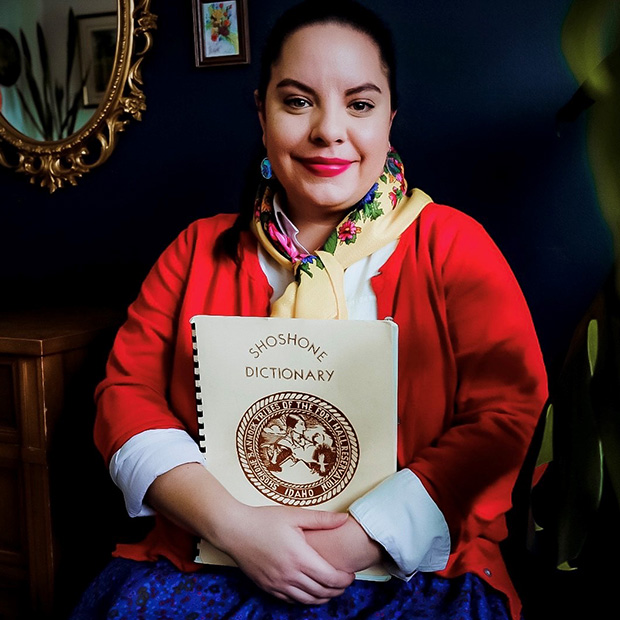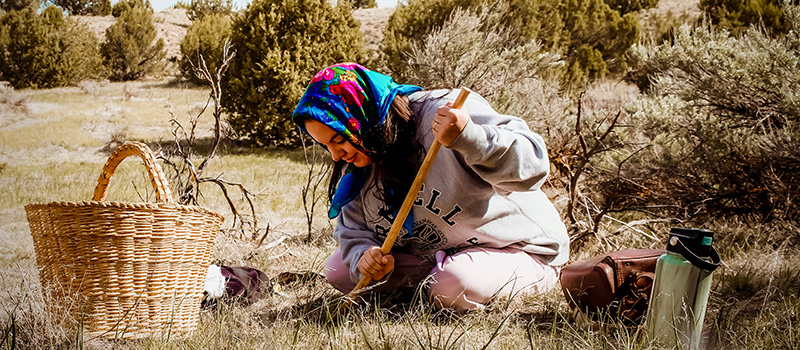Grinnell alumna from Shoshone-Bannock Tribes is helping bring back ancestral language
April 21, 2023 — “Ever since I was a little girl, I’ve always loved school,” says Bailey Dann ’17. “School was my safe place, which is interesting when I think about my traumatic generational history of schooling.”
Dann is from the Shoshone-Bannock Tribes of Fort Hall, Idaho. She was matched to Grinnell as a QuestBridge Scholar. A first-generation college student, she recalls a field trip she took in second grade to visit a college campus. “That was when I first realized you could go to college as a grown up. It was the best day of my life,” she says. “I made a commitment to myself that I’d go to college, and I kept it.”
Raised by her grandparents and great grandparents, Dann’s grandmother was not happy she was moving so far away from their Idaho home. Yet she also recognized the importance of the opportunity Grinnell offered. “My grandfather drove me across so many states to get there,” says Dann. “I vividly remember seeing the rolling hills of corn for the first time. I literally went from mountains to cornfields.”
 Bailey Dann ’17
Bailey Dann ’17
Dann was a triple major, studying studio art, anthropology, and education. “I learned a lot from Grinnell. It helps you be the architect of your own life, using more than just one perspective. It gave me a holistic approach to the work I do.”
Upon graduation, Dann returned to Fort Hall, Idaho, planning to take the summer to plan next steps in pursuing a teaching career. But soon into this process, her phone rang. It was the principal of Chief Taghee Elementary, a Shoshoni language dual-immersion charter school.
“They wanted me to come for an interview, and I hadn’t even applied for a job,” she marvels. “This is the way my community works because everyone knows everyone. They will find you even if you don’t want to be found.”
Dann only knew a few Shoshoni phrases yet agreed to work as a Shoshoni language teacher. “I had always had an interest in the language,” she recalls. “When I was little, my dad gave me a Shoshoni language dictionary. He told me it was important.” It is still a cherished possession that traveled with her to Grinnell and back.
Before her first day of teaching, Dann had a dream. “I was with my elders from long ago. They were my relatives I had seen in photos. We were sitting around a fire, and they were praying and talking to me in their language,” she says. “When I woke up, I felt their presence, telling me that this was what I was meant to do. I hold that moment close. This type of work is heavy, but even today, I know they are with me.”
For the most part, Dann’s family doesn’t speak the Shoshoni or Bannock languages anymore. “Four decades ago they did, but the Indian boarding school system changed that,” she says.
Dann’s great-great-great grandmother was a part of that system, attending and graduating from the Carlisle Indian Industrial School in Pennsylvania where hundreds of children died. These schools forced assimilation, severely punishing students who tried to retain any part of their culture whether in appearance, language, or any other ways. Dann is painfully aware of other ancestors who also attended Indian boarding schools in different states, including a boarding school that operated in Fort Hall until 1935.
 Dann is pictured harvesting genka, or wild onions, with her bodo, a traditional Shoshone digging tool that she made.
Dann is pictured harvesting genka, or wild onions, with her bodo, a traditional Shoshone digging tool that she made.
“Our language has not been spoken in my family since those times except in little bits and pieces here and there,” Dann says. “One of my gifts is language learning, and I’ve been fortunate to be able to gain fluency in Shoshoni by learning from elders in our community.”
Currently, Dann is pursuing a master’s degree from Idaho State University in linguistic anthropology. Her graduate thesis focuses on an accessible curriculum guide for Indigenous language teaching and planning.
“A guide like this doesn’t exist within my community,” she says. “I’m applying specific methods and theories that envelop the whole learner. A big part of my project is letting others know they are not alone. It is intensive work, but we are here. It takes an entire community to bring back a language.”
About 60 people (around 1 percent of the population) speak the Shoshoni language fluently in Fort Hall, and most are over the age of 75. Even fewer people speak the Bannock language, which currently has 10 living speakers.
Along with graduate school, Dann is an Indian Education paraeducator at her home school district, Blackfoot School District #55. “I grew up in mostly white schools, where I didn’t always feel like I belonged,” she says. “As an educator, I’m looking for ways to interrupt the Western colonial way of schooling and find ways to support Indigenous students in these spaces.”
A crucial part of her teaching focuses on incorporating Indigenous methodologies such as storytelling. She gives an example of how numbers are said in Shoshoni. The word for one million is a word describing the number of hairs on a deer hide, a concept she knows well.
“I can’t just teach the language without participating in my community and culture,” she explains. “When I’m scraping a deer hide, I can believe that it has more than a million hairs. Our language is very descriptive and tells entire stories within words.”
Also an artist, Dann’s incorporation of storytelling continues through this medium. Her 2020 wall art installation at the Museum of Idaho depicts an ancient Shoshoni story about two brothers. “I love opportunities like this to share our worldview with the wider public, particularly our children who are often watching and learning from us,” she says.
“My own art pays homage to my family,” she explains. “I come from a culture deeply embedded in visual and oral history. Elders have always told me that what you say and create in the world is sacred, because your energy is woven into your words and art.”
Dann is eager to explore various opportunities to share her curriculum work and research on Indigenous language revitalization.
“I don’t just want it sitting on a library shelf. I want it to be continually used and revised,” she explains. “I’m still exploring how to develop a model that can shapeshift to what a community needs.”
— by Melanie Drake ’92